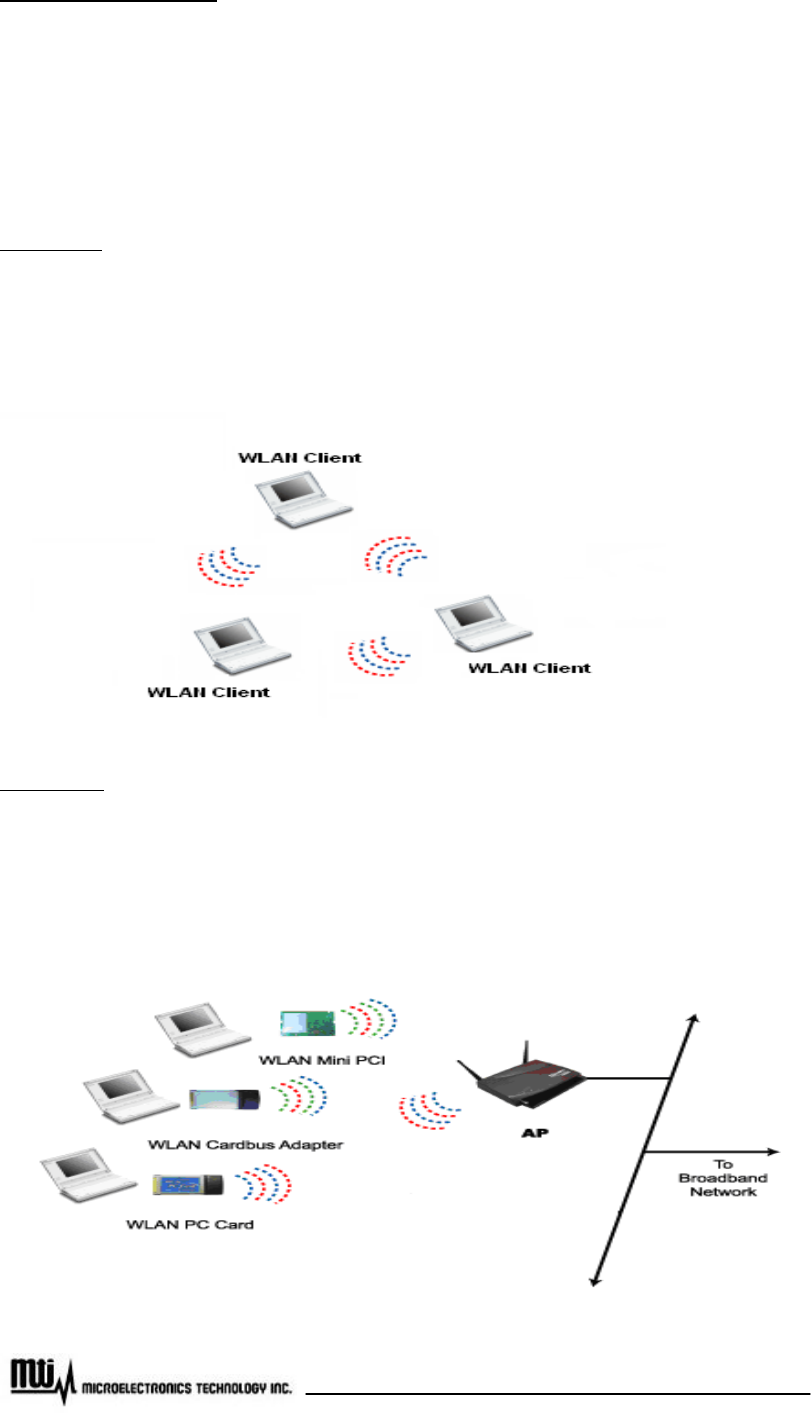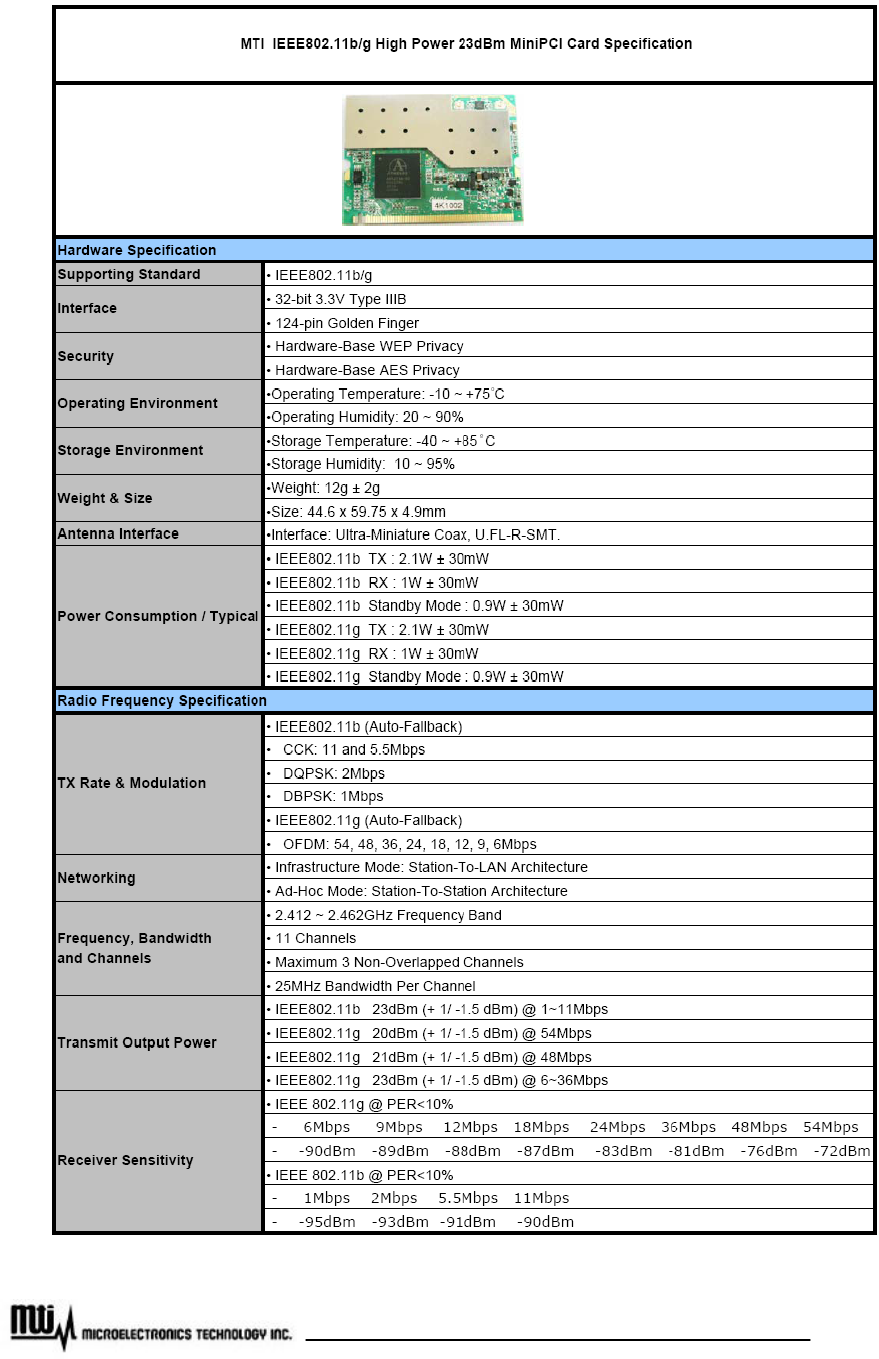Microelectronics Technology MB2411H 802.11b/g MiniPCI Card 23dBm User Manual MB2411H 802
Microelectronics Technology Inc 802.11b/g MiniPCI Card 23dBm MB2411H 802
Manual

MB2411H 802.11 b/g Mini PCI Card
User Manual
Version 1.0
Microelectronics Technology Inc. Proprietary
Copyright © 2005 Microelectronics Technology Inc.
Notice of Proprietary Information
This document and its contents are proprietary to
Microelectronics Technology Inc. and are intended solely
for the internal use of Microelectronics Technology Inc.
This publication and its contents may not be reproduced
or distributed for any other purpose without the written
permission of Microelectronics Technology Inc.
Microelectronics Technology Inc. Proprietary

Version History
Version Date Remark
1.0 Nov. 25 2005 Initial Version
Microelectronics Technology Inc. Proprietary

Introduction
The Mti MB2411H is Mti 2.4GHz Mini PCI Card. The supporting channel is from 2412GHz to
2462 GHz as the FCC standard over the 2.4GHz part. The design is to enhance your
wireless environment. The 23dBm/200mW output power will also enhance our product
strength over the data transmitting and receiving. You could also use this device to plug into
the client devices with Mini PCI Slot to enrich your wireless experience.
The following paragraph will descript the Mti MB2411H Mini PCI Card’s feature & benefit,
system requirement, application, and network configuration.
Feature and Benefit
‧ Up to 54Mbps high speed data rate
‧ WPA / AES Encryption Security
‧ Operating in High Temperature
‧ Light weight
System Requirement
The following items are the minimum requirement in order to use the Mini-PCI card.
‧ Notebook or other Client Devices containing a 32-bit PCI Slot
‧ Window 98/ME/2000/XP operating system
‧ 300 MHz or higher processor
Application
The WLAN products are easy to install and highly efficient. The following items will state some applications
could make possible to access the power and flexibility of WLAN:
‧ Difficult-To-Wired Environment – Offer the remote Internet Access
‧ Ethernet Network or Another Wireless LAN Backup – To secure some critical
communication
‧ The Ability For The Real-Time Information Transmitting – Working Places, Hot Spots
‧ Small Office and Home Office network / SOHO -- Easy, Cost-effective and Quick Installation
‧ Campus or Educational Environment – Internet Access for Information or Researching
Microelectronics Technology Inc. Proprietary

Network Configuration
There are two network modes in Wireless LAN environment as following:
‧ Ad-Hoc / Peer-to-Peer Mode
‧ Infrastructure
Ad-Hoc Mode
In Ad-Hoc mode is peer-to-peer networking, each client could access other clients and does not require
an access point in this network configuration.
Infrastructure
The infrastructure mode requires an access point. In this mode, all client notebooks want to
communicate with each other need to go through the access point. You could put our Mini PCI card either in
Notebook or in AP client device as the following figure.
Microelectronics Technology Inc. Proprietary

Install Mini PCI
This paragraph will talk about the installation under the Window Platform 98/ ME/ 2000/ XP.
Start Configuration
You need to remove other wireless card and turn off its driver utility first then plug the mini PCI card in and
start loading the PCI card's driver.
Install Mini PCI card in notebook
‧ Turn off the notebook power.
‧ Take off the notebook battery.
‧ Insert the Mini PCI card into slot
‧ Install the Atheros Mini PCI driver and click the setup
Install Mini PCI card into the client device slot
‧ Make sure the power is off or unplug the power cord from the device first
‧ Insert the Mini PCI card into slot
‧ Install the Atheros Mini PCI driver and click the setup
Microelectronics Technology Inc. Proprietary

Appendix A - Trouble Shooting
The following description is to help to you do the trouble shooting in case you encounter some
difficult to install and use the MB2411H Mini PCI Card.
When the window doesn’t detect the card installation
‧ Make sure you install the Mini PCI Card properly into the slot.
‧ Check your computer or Laptop has the “Plug and Play” BOIS.
‧ Window might not detect the Mini PCI Card if the previous card did not
cancel completely. Please, remove and re-install it again.
Fail to load the Driver
‧ There may have the resource conflict. Please, go to the device
manager to resolve the conflict.
Conflict with the Window Platform
‧ The device conflict might be related to the PC card. Please, use the
computer property to identify the conflict root cause.
No any conflict was detected but still could not attach the network
‧ Make sure you install the proper driver.
‧ Check the SSID is the same as the AP.
Microelectronics Technology Inc. Proprietary

Appendix B – Product Specification
Microelectronics Technology Inc. Proprietary

Federal Communication Commission Interference Statement
This equipment has been tested and found to comply with the limits for a Class B digital device,
pursuant to Part 15 of the FCC Rules. These limits are designed to provide reasonable
protection against harmful interference in a residential installation. This equipment generates,
uses and can radiate radio frequency energy and, if not installed and used in accordance with the
instructions, may cause harmful interference to radio communications. However, there is no
guarantee that interference will not occur in a particular installation. If this equipment does
cause harmful interference to radio or television reception, which can be determined by turning
the equipment off and on, the user is encouraged to try to correct the interference by one of the
following measures:
- Reorient or relocate the receiving antenna.
- Increase the separation between the equipment and receiver.
- Connect the equipment into an outlet on a circuit different from that
to which the receiver is connected.
- Consult the dealer or an experienced radio/TV technician for help.
This device complies with Part 15 of the FCC Rules. Operation is subject to the following two
conditions: (1) This device may not cause harmful interference, and (2) this device must accept
any interference received, including interference that may cause undesired operation.
FCC Caution: Any changes or modifications not expressly approved by the party responsible for
compliance could void the user's authority to operate this equipment.
IMPORTANT NOTE:
FCC Radiation Exposure Statement:
This equipment complies with FCC radiation exposure limits set forth for an uncontrolled
environment. This equipment should be installed and operated with minimum distance 20cm
between the radiator & your body.
This transmitter must not be co-located or operating in conjunction with any other antenna or
transmitter.
IEEE 802.11b or 802.11g operation of this product in the U.S.A. is firmware-limited to channels 1
through 11.
Microelectronics Technology Inc. Proprietary

This device is intended only for OEM integrators under the following conditions:
The antenna must be installed such that 20 cm is maintained between the antenna and users,
and the transmitter module may not be co-located with any other transmitter or antenna.
As long as 2 conditions above are met, further transmitter test will not be required. However, the
OEM integrator is still responsible for testing their end-product for any additional compliance
requirements required with this module installed (for example, digital device emissions, PC
peripheral requirements, etc.).
IMPORTANT NOTE:
In the event that these conditions can not be met (for example certain laptop configurations or
co-location with another transmitter), then the FCC authorization is no longer considered valid
and the FCC ID can not be used on the final product. In these circumstances, the OEM integrator
will be responsible for re-evaluating the end product (including the transmitter) and obtaining a
separate FCC authorization.
End Product Labeling
This transmitter module is authorized only for use in device where the antenna may be installed
such that 20 cm may be maintained between the antenna and users. The final end product must
be labeled in a visible area with the following: “Contains TX FCC ID: MAD-MB2411H”.
Manual Information That Must be Included
The OEM integrator has to be aware not to provide information to the end user regarding how to
install or remove this RF module in the users manual of the end product which integrate this
module.
The users manual for OEM integrators must include the following information in a prominent
location “ IMPORTANT NOTE: To comply with FCC RF exposure compliance requirements, the
antenna used for this transmitter must be installed to provide a separation distance of at least 20
cm from all persons and must not be co-located or operating in conjunction with any other
antenna or transmitter.
Microelectronics Technology Inc. Proprietary